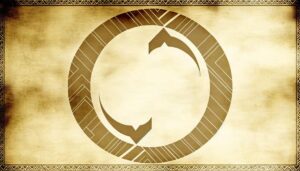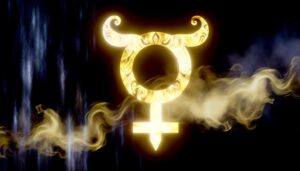What Is the Meaning of the Rod of Asclepius in Medical Symbols?
The medical symbol, primarily the Rod of Asclepius, is an emblem of healing and medicine that features a serpent entwined around a staff. Rooted in Greek mythology, it represents Asclepius, the god of medicine, embodying the balance between life and death, as well as the transformative and restorative aspects of healthcare.
The serpent symbolizes healing, danger, and rebirth, reflecting its broad cultural significance. Different medical organizations globally adopt variations of this symbol, and it's often confused with the Caduceus of Hermes.
Understanding its rich historical and cultural context enhances its appreciation in modern medicine. Discover more about its profound symbolism and global adaptations.
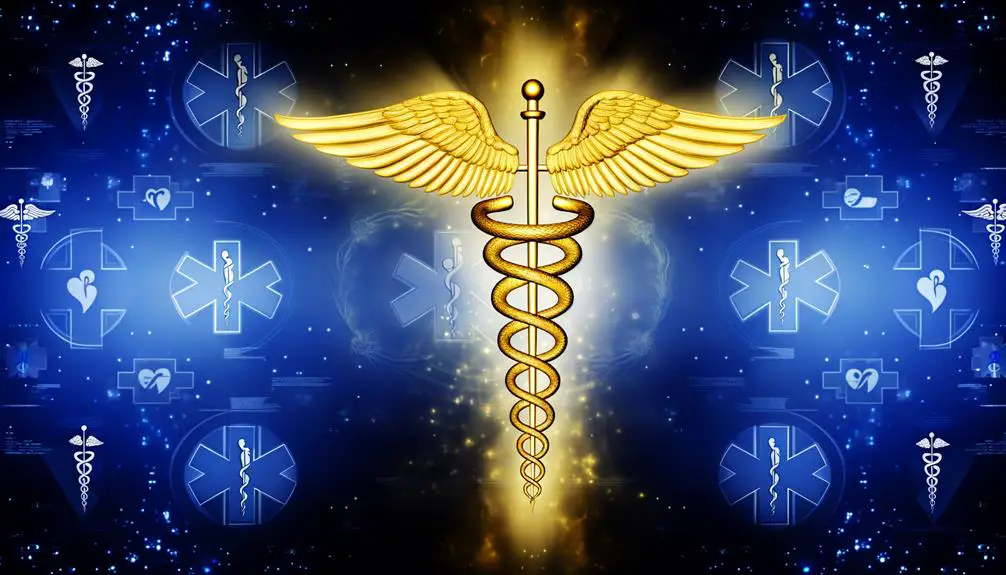
Key Takeaways
- The Rod of Asclepius, with a serpent entwined around a staff, symbolizes healing and medicine.
- Originating from Greek mythology, it is linked to Asclepius, the god of medicine.
- The serpent represents healing, rebirth, and transformation across various cultures.
- Modern medical organizations use this symbol to signify healing, wisdom, and protection.
- The Rod of Asclepius is globally recognized and fosters trust and authority in the medical profession.
Rod of Asclepius

The Rod of Asclepius, an ancient Greek symbol associated with healing and medicine, features a single serpent entwined around a staff and is widely recognized as a representation of the medical profession.
This emblem carries profound significance, symbolizing the intricate balance between life and death, health and disease. The serpent, often perceived as a creature of wisdom and rejuvenation, highlights the transformative and restorative powers attributed to medical practice.
The staff signifies authority and support, embodying the pivotal role of healthcare providers. This symbol's adoption by various medical organizations underscores its enduring relevance and universality.
Its unifying imagery conveys the timeless pursuit of human well-being, aligning with the core principles of medical ethics and patient care.
Origins in Greek Mythology

Rooted in the rich tapestry of Greek mythology, the Rod of Asclepius draws its origins from the revered figure of Asclepius, the god of medicine and healing. This ancient symbol reflects the profound influence of Greek mythology on medical practices and iconography.
Asclepius, son of Apollo and the mortal Coronis, was renowned for his exceptional healing abilities, which were believed to be granted by divine intervention. His legacy includes:
- Establishment of healing temples known as Asclepieia
- Reverence for holistic approaches combining physical and spiritual healing
- Influence on early medical practices and ethics
- Integration into the Hippocratic Oath
- Representation in various ancient Greek texts and artifacts
These elements underscore the enduring impact of Asclepius on the medical field.
Symbolism of the Serpent
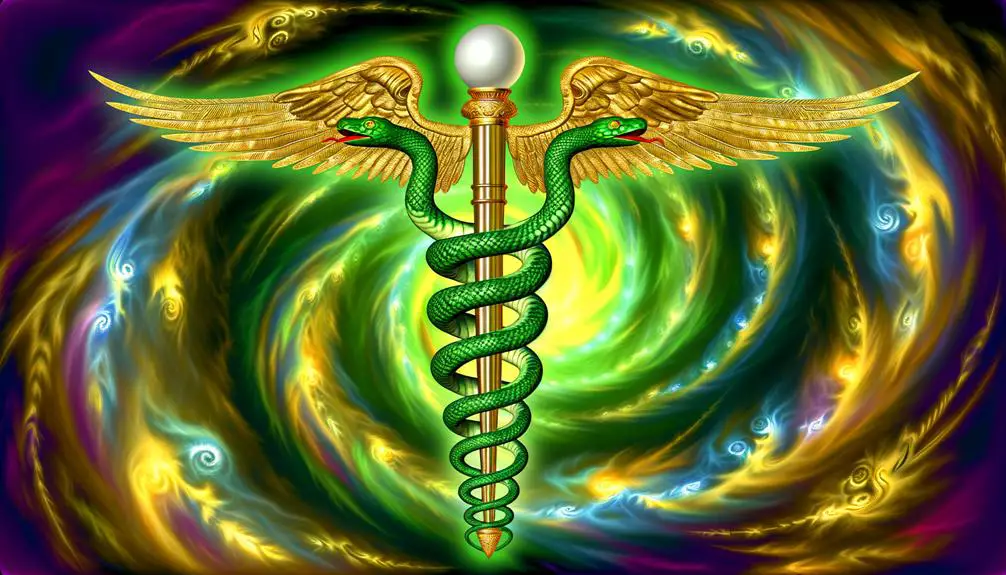
The serpent, an enduring emblem across various ancient cultures, encapsulates profound healing symbolism and the dual nature of medicine as both a life-preserving and potentially dangerous force.
This duality is vividly represented in the serpent's association with rejuvenation and poison, reflecting the intricate balance within medical practice.
Contemporary adoption of the serpent in medical symbols underscores its historical significance and ongoing relevance in representing the field's complexities.
Ancient Healing Symbolism
Emerging from ancient mythology and cultural practices, the serpent has long been revered as a potent symbol of healing and renewal, intricately woven into the fabric of medical iconography. Ancient civilizations recognized the serpent's ability to shed its skin as a metaphor for rebirth and transformation.
This symbolic resonance is reflected in various cultures:
- Greek mythology: The Rod of Asclepius, entwined by a single snake, represents health and medicine.
- Hindu tradition: The serpent symbolizes Kundalini energy, which signifies spiritual awakening and healing.
- Ancient Egypt: The Uraeus serpent was a protector and a symbol of divine authority and health.
- Chinese culture: The serpent is associated with wisdom, longevity, and medicinal knowledge.
- Mesoamerican civilizations: Quetzalcoatl, the feathered serpent, embodies fertility and life.
These diverse associations underscore the serpent's universal emblematic connection to healing.
Dual Nature Representation
Throughout history, the serpent's dual nature as both a healer and a harbinger of danger has made it a complex and multifaceted symbol in medical iconography.
On one hand, the serpent's association with rejuvenation and healing is evident in its ability to shed its skin and emerge renewed. This regenerative quality has been revered in various ancient cultures, including Greek mythology, where it is linked to Asclepius, the god of medicine.
Conversely, the serpent's venomous potential underscores its role as an agent of danger, symbolizing the delicate balance between life and death. This dichotomy reflects the inherent complexities of medical practice, where the potential for harm coexists with the promise of healing, encapsulating the profound responsibilities carried by medical professionals.
Modern Medical Adoption
Incorporating the serpent into modern medical symbolism reflects a nuanced understanding of its historical and cultural significance, bridging ancient wisdom with contemporary medical practice. This emblem, prominently featuring the Rod of Asclepius, signifies various pertinent aspects:
- Healing and Medicine: The serpent embodies rejuvenation, shedding its skin to symbolize healing.
- Wisdom and Knowledge: Historically, serpents are associated with insight and the pursuit of medical knowledge.
- Balance: Representing the duality of poison and remedy, it highlights the delicate balance in medical treatments.
- Protection: The serpent's vigilance underscores the medical profession's duty to guard health.
- Continuity: Its enduring presence connects ancient practices with modern medicine, emphasizing an unbroken lineage of care.
These elements collectively enhance the emblem's relevance in contemporary healthcare.
Caduceus Confusion
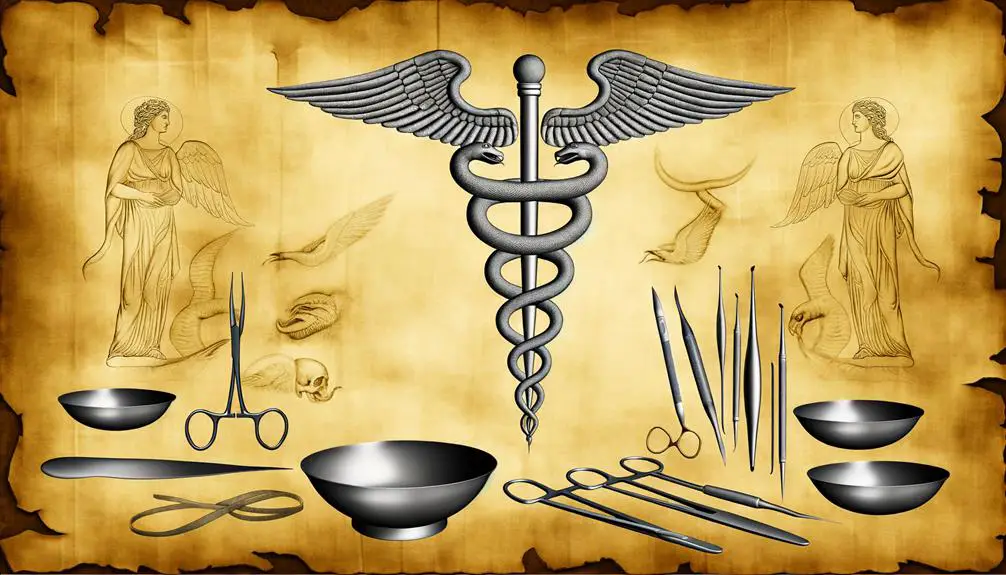
The widespread misconception between the caduceus and the Rod of Asclepius, two distinct symbols often conflated in medical contexts, reveals a deeper historical and cultural misunderstanding. The caduceus, characterized by two snakes entwined around a winged staff, is traditionally associated with Hermes, the god of commerce and trade. Conversely, the Rod of Asclepius, featuring a single serpent entwined around a staff, is linked to Asclepius, the Greek deity of healing and medicine. This confusion has led to the erroneous adoption of the caduceus by some medical organizations, despite its commercial rather than medical roots.
| Symbol | Description | Association |
|---|---|---|
| Caduceus | Two snakes, winged staff | Hermes (Commerce, Trade) |
| Rod of Asclepius | Single snake, plain staff | Asclepius (Healing, Medicine) |
| Usage Context | Often mistakenly used in medical settings | Correctly used in medical contexts |
Historical Usage
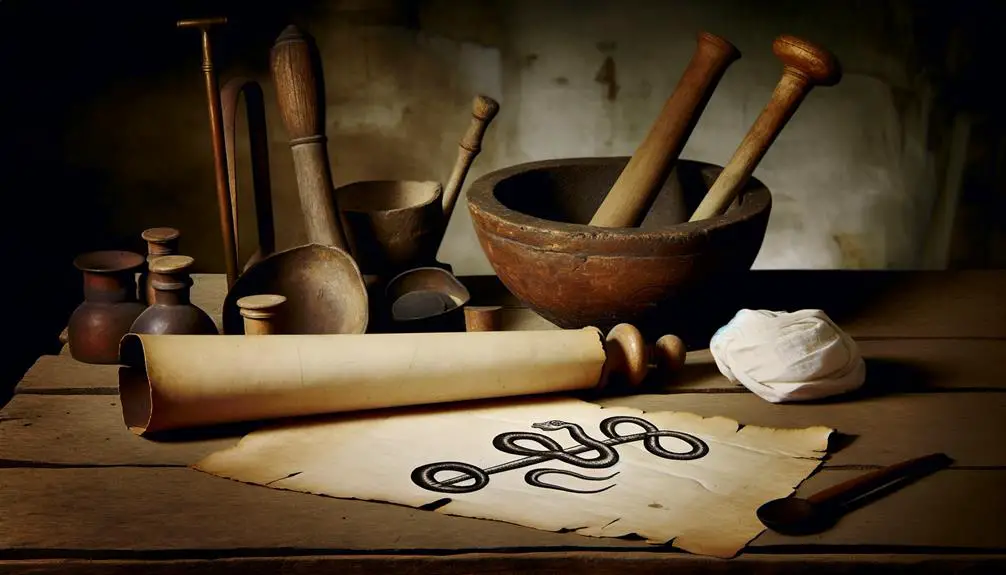
Tracing the historical usage of medical symbols reveals a nuanced evolution influenced by cultural exchanges and practical necessities in ancient civilizations. Medical symbols served as more than mere identifiers; they embodied profound meanings and conveyed critical information.
The Rod of Asclepius, for instance, symbolizes healing and medicine, derived from Greek mythology. Other symbols reflect diverse origins and purposes:
- Rod of Asclepius: Affiliated with Greek god Asclepius, representing healing.
- Serpent: Symbolizing rejuvenation and transformation due to its shedding skin.
- Cross: Used by the Knights Hospitaller, signifying care and protection.
- Eye of Horus: Employed in ancient Egypt, believed to provide magical protection.
- Apothecary's Mortar and Pestle: Denoting pharmaceutical practice.
These symbols illustrate the interplay between mythology, culture, and medical practice across history.
Modern Medical Adoption

Modern medical adoption of ancient symbols demonstrates a seamless blend of historical reverence and contemporary significance, reflecting both the enduring legacy and the evolving context of healthcare.
The caduceus and the Rod of Asclepius, each rooted in mythological lore, have transcended their origins to become emblematic of modern medical practice.
The caduceus, often mistakenly used, embodies commerce and negotiation, while the Rod of Asclepius, with its single serpent, accurately represents healing and medicine. This misappropriation highlights the dynamic interplay between historical symbolism and current usage.
Healthcare institutions leverage these symbols to convey trust, authority, and continuity, underscoring their mission to heal. Therefore, ancient icons serve as profound touchstones in the ever-advancing field of medicine.
Global Recognition

Across diverse cultures and healthcare systems, the universal adoption of medical symbols like the Rod of Asclepius exemplifies their profound global recognition and unifying impact. The Rod of Asclepius, featuring a serpent entwined around a staff, is recognized internationally as a representation of health and healing. This symbol's omnipresence underscores several key aspects:
- Universality: Recognized by medical professionals and the public worldwide.
- Historical significance: Rooted in ancient Greek mythology, symbolizing medicine's long-standing traditions.
- Cultural integration: Adapted and respected across different healthcare systems.
- Professional identity: Emblematic of the medical profession, fostering trust and authority.
- Educational value: Used in medical education to instill ethical and professional standards.
This widespread acknowledgment highlights the symbol's integral role in global healthcare.
Variations Across Cultures
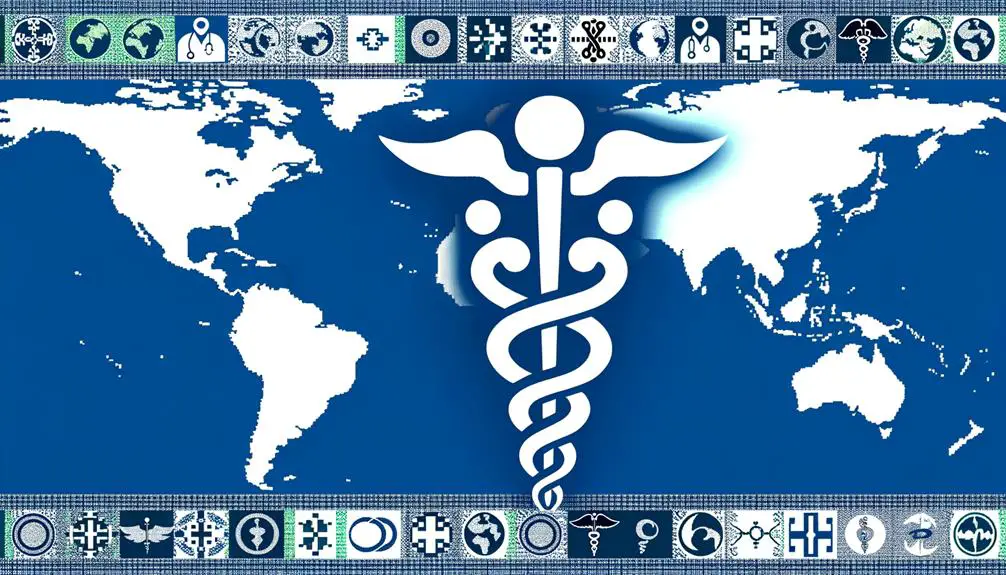
Variations in the medical symbol across cultures reveal significant differences in symbolic interpretation, influenced by historical contexts and regional traditions.
For instance, while the Rod of Asclepius is widely recognized in Western medicine, other cultures may utilize symbols such as the Red Cross or the Snake and Staff of Hermes.
These adaptations reflect not only varying historical narratives but also cultural practices that shape the representation and understanding of medical care.
Cultural Symbolic Differences
The interpretation of the medical symbol varies greatly across different cultures, reflecting a rich tapestry of historical, religious, and social influences that shape its meaning and usage. These differences can be seen in the distinct symbols and their connotations within various societies:
- Western cultures often use the Rod of Asclepius, associating it with healing and medicine.
- Eastern traditions might incorporate symbols like the Yin-Yang, emphasizing balance in health.
- Indigenous cultures may utilize animal imagery, representing natural healing forces.
- Middle Eastern societies often integrate symbols from Islamic medicine, focusing on holistic wellness.
- African cultures sometimes employ ancestral symbols, highlighting the role of heritage and community in health.
These cultural nuances underscore the importance of context in understanding medical symbolism globally.
Historical Context Variations
Throughout history, the evolution of medical symbols has been deeply influenced by the unique cultural, religious, and philosophical contexts of various societies.
In ancient Greece, the Rod of Asclepius, entwined with a single serpent, symbolized healing and medicine, reflecting the god Asclepius's association with health.
Similarly, in ancient Egypt, the Eye of Horus was believed to possess protective and restorative powers, often used in medical contexts.
In contrast, traditional Chinese medicine employed the Yin-Yang symbol to convey balance and harmony fundamental to health.
Each culture's symbolic language encapsulated its worldview and medical philosophy, resulting in varied emblematic representations.
These historical variations underscore the profound interplay between cultural beliefs and medical practices, shaping the global lexicon of medical symbolism.
Symbol Adaptation Practices
Across different cultures, the adaptation of medical symbols reflects a nuanced synthesis of traditional beliefs, contemporary practices, and local interpretations. Each culture imbues these symbols with unique meanings, resulting in variations that are both rich and complex.
For instance:
- The Rod of Asclepius: Mainly used in Western medicine, symbolizing healing and medicine.
- The Red Cross: Universally recognized but adapted differently depending on regional humanitarian needs.
- The Caduceus: Often mistakenly used in place of the Rod of Asclepius in the United States, associated with commerce and negotiation.
- The Green Cross: Utilized in some countries to indicate pharmacies.
- The Lotus Flower: In Eastern cultures, symbolizing purity and health.
These variations underscore how medical symbols are not merely static emblems but dynamic representations shaped by cultural contexts.
Misinterpretations and Controversies
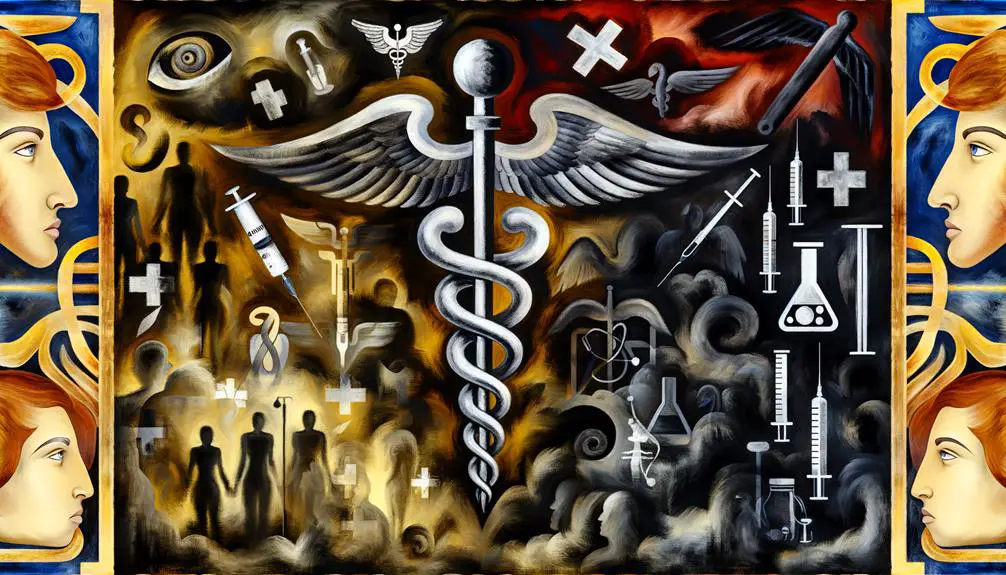
Misinterpretations of the medical symbol often stem from its intricate historical origins and the various cultural contexts in which it is used.
The Caduceus, featuring two serpents entwined around a winged staff, is frequently confused with the Rod of Asclepius, which has a single serpent and no wings. The former is traditionally associated with Hermes, the Greek god of commerce and trickery, while the latter symbolizes healing and medicine, linked to Asclepius, the Greek deity of healing.
This confusion has led to debates within the medical community about the appropriateness of using the Caduceus as a medical emblem. Such controversies underscore the importance of understanding the historical and cultural significance behind symbols to guarantee their accurate and respectful application.
Conclusion
The Rod of Asclepius, with origins in Greek mythology, has evolved into a globally recognized medical symbol.
Surprisingly, a 2006 study found that 62% of healthcare organizations erroneously use the caduceus, which historically represents commerce, instead of the Rod of Asclepius.
This confusion underscores the importance of accurate symbolism in professional fields.
Despite cultural variations and occasional misinterpretations, the Rod of Asclepius remains a powerful emblem of healing and medical practice worldwide.

